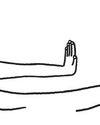
In 1627, a professional lace-maker named Thomasine Hall boarded a ship in England and arrived at Jamestown, Virginia, to become a maidservant in the household of a man named John Tyos. Women of English origin were scarce in that part of the New World, amid the recently established and extremely laborintensive tobacco plantations. A count conducted in 1624 recorded only two hundred and thirty adult women among the twelve hundred and fifty Europeans living in Virginia. Women were urgently needed for marital fellowship and procreation, and male settlers paid the Virginia Company the considerable sum of a hundred and fifty pounds a head for the transportation of prospective wives across the Atlantic. Females were also in demand for their gender-specific domestic skills. This was Hall’s value to Tyos. As an experienced seamstress, Hall, who was twenty-five or so, would have made clothing and other items. Additional duties would likely have included cooking, cleaning, candle-making, and other forms of women’s work.
But was Hall really a woman? After Hall had been living in Tyos’s household for a year or two, rumors started to spread that the supposed maidservant was—in the assessment of one male neighbor—“a man and woeman.” It fell to three local women to perform a physical examination of Hall’s genitals and make their own determination. When their investigation convinced them that Hall was male, the matter came to the attention of Captain Nathaniel Basse, whose military rank and past service in colonial government made him the community’s unofficial leader. Basse asked Hall, Are you a man or a woman? According to a partially surviving record of the exchange, from the Virginia General Court, in Jamestown, Hall “replyed that hee was both.”
This story is from the {{IssueName}} edition of {{MagazineName}}.
Start your 7-day Magzter GOLD free trial to access thousands of curated premium stories, and 9,000+ magazines and newspapers.
Already a subscriber ? Sign In
This story is from the {{IssueName}} edition of {{MagazineName}}.
Start your 7-day Magzter GOLD free trial to access thousands of curated premium stories, and 9,000+ magazines and newspapers.
Already a subscriber? Sign In

BADDIE ISSUES
\"Wicked\" and \"Gladiator II.\"

LET'S MAKE A DEAL
\"Death Becomes Her\" and \"Burnout Paradise.\"

ANTI HEROES
\"The Franchise,\" on HBO.

FELLOW-TRAVELLERS
The surprisingly sunny origins of the Frankfurt School.

NOW YOU SEE ME
John Singer Sargent's strange, slippery portraits of an art dealer's family.

PARIS FRIEND - SHUANG XUETAO
Xiaoguo had a terror of thirst, so he kept a glass of water on the table beside his hospital bed. As soon as it was empty, he asked me to refill it. I wanted to warn him that this was unhealthy - guzzling water all night long puts pressure on the kidneys, and pissing that much couldn't be good for his injury. He was tall, though, so I decided his insides could probably cope.

WILD SIDE
Is Lake Tahoe's bear boom getting out of hand?

GETTING A GRIP
Robots learn to use their hands.

WITHHOLDING SEX FROM MY WIFE
In the wake of [the] election, progressive women, who are outraged over Donald Trump's victory at the ballot box, have taken to social media with public, vengeful vows of chastity. - The Free Press.

DEADLINE EXTENSION
Old age, reborn.